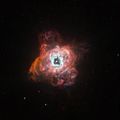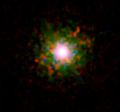Circinus facts for kids
| Constellation | |

List of stars in Circinus
|
|
| Abbreviation | Cir |
|---|---|
| Genitive | Circini |
| Pronunciation | Círcinus, genitive |
| Symbolism | Compass |
| Right ascension | 13h 38.4m to 15h 30.2m |
| Declination | −55.43° to −70.62° |
| Quadrant | SQ3 |
| Area | 93 sq. deg. (85th) |
| Main stars | 3 |
| Bayer/Flamsteed stars |
9 |
| Stars with planets | 2 |
| Stars brighter than 3.00m | 0 |
| Stars within 10.00 pc (32.62 ly) | 0 |
| Brightest star | α Cir (3.19m) |
| Messier objects | 0 |
| Meteor showers | Alpha Circinids (ACI) |
| Bordering constellations |
Centaurus Musca Apus Triangulum Australe Norma Lupus |
| Visible at latitudes between +30° and −90°. Best visible at 21:00 (9 p.m.) during the month of July. |
|
Circinus is a small, faint group of stars, also known as a constellation, located in the southern sky. A French astronomer named Nicolas-Louis de Lacaille first officially described it in 1756. Its name comes from a Latin word meaning "compass." This refers to the drafting tool used for drawing circles. It's not the same as Pyxis, which is a constellation representing a mariner's compass that points north. The brightest star in Circinus is called Alpha Circini.
Cool Facts About Circinus
The Milky Way galaxy, our home galaxy, actually passes right through the Circinus constellation. This means you can see many stars and cosmic dust clouds in this area.
Meteor Showers
Circinus is also where an annual meteor shower appears to come from. This shower is called the Alpha Circinids (ACI). It was first seen in Queensland, Australia, in 1977.
These meteors travel very fast, about 27.1 kilometers per second! Scientists think they are linked to a long-period comet. In 2011, a scientist named Peter Jenniskens suggested that the dust left behind by comet C/1969 T1 might cross Earth's path. This could cause a sudden burst of meteors. The Alpha Circinids shower is usually strongest on June 4th, which is the day it was first discovered.
Images for kids
-
Hubble Space Telescope's view of NGC 5315, showing its intricate structure and central star
-
The Chandra X-ray Observatory's false-color image of Circinus X-1 showing its jets
See also
 In Spanish: Circinus para niños
In Spanish: Circinus para niños




